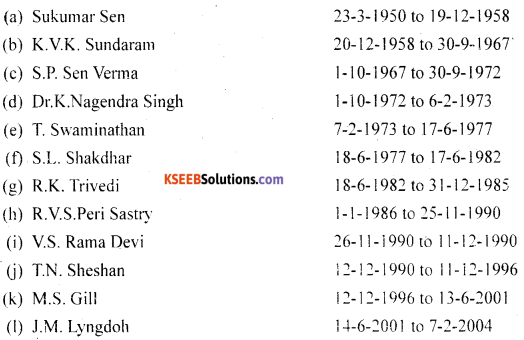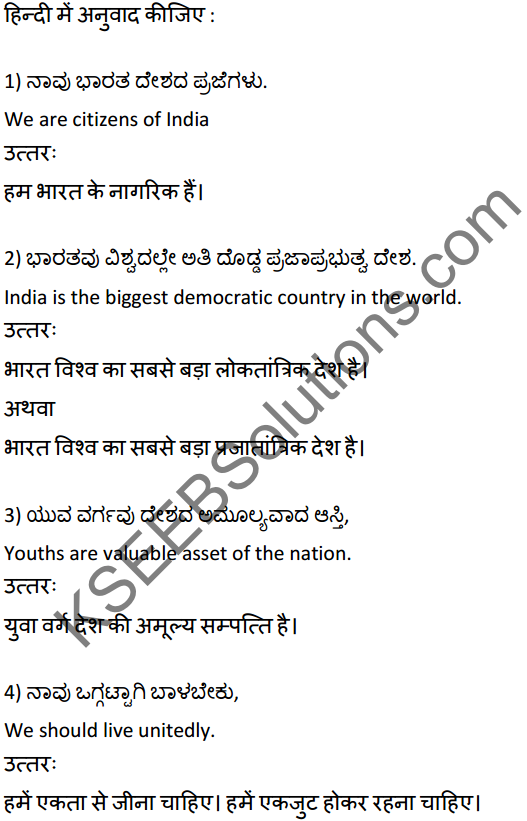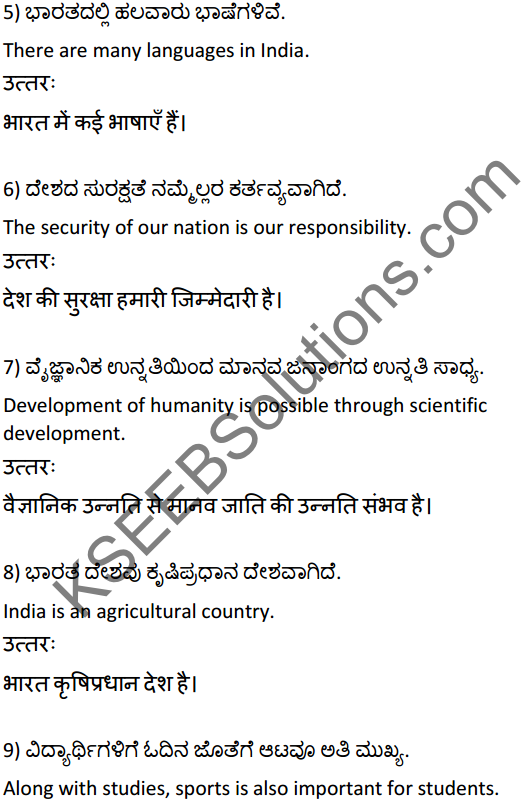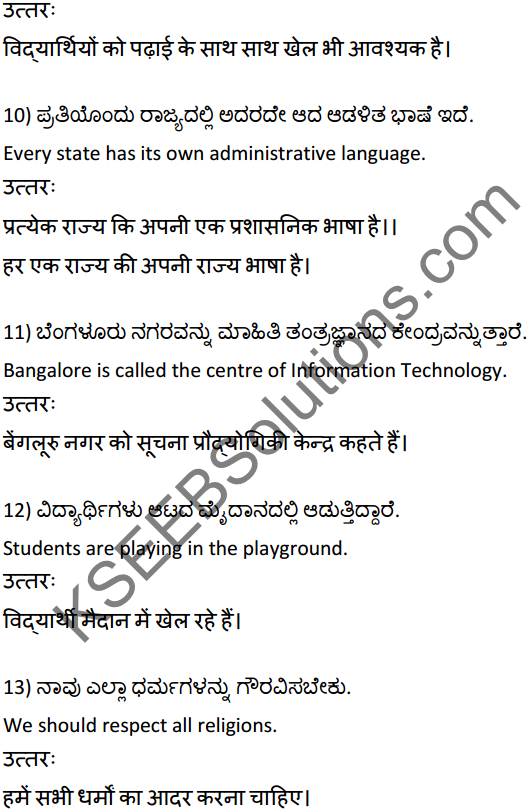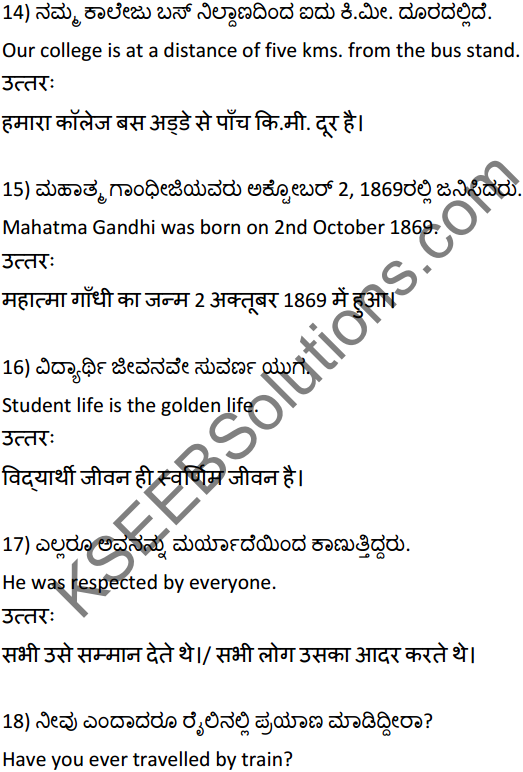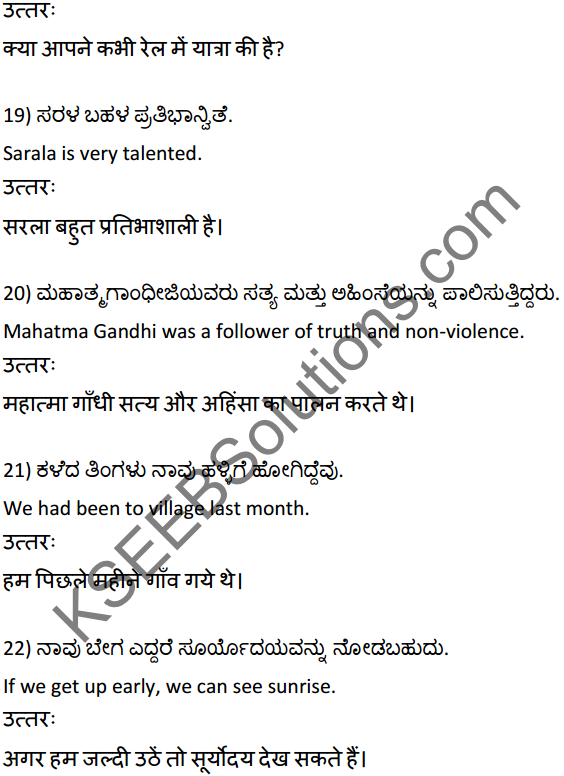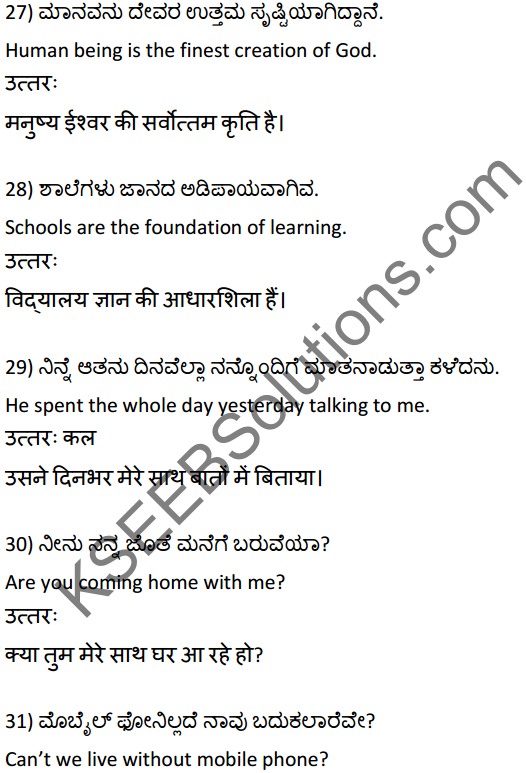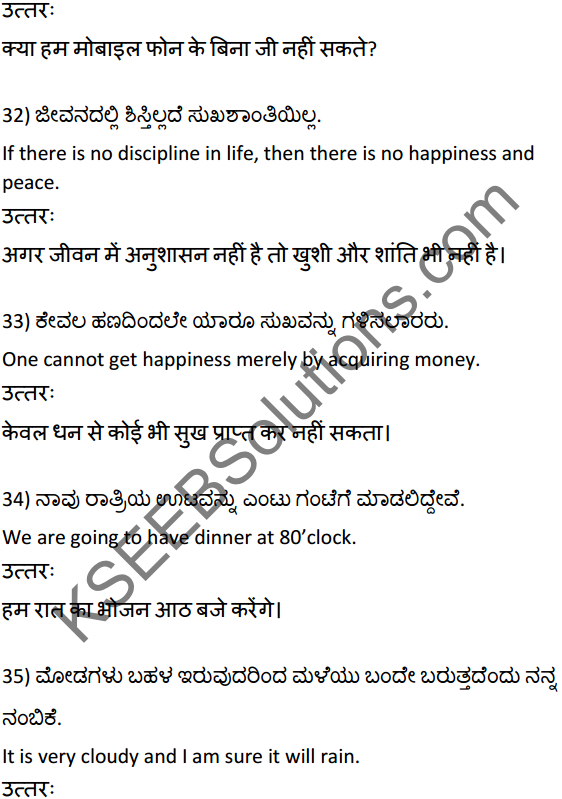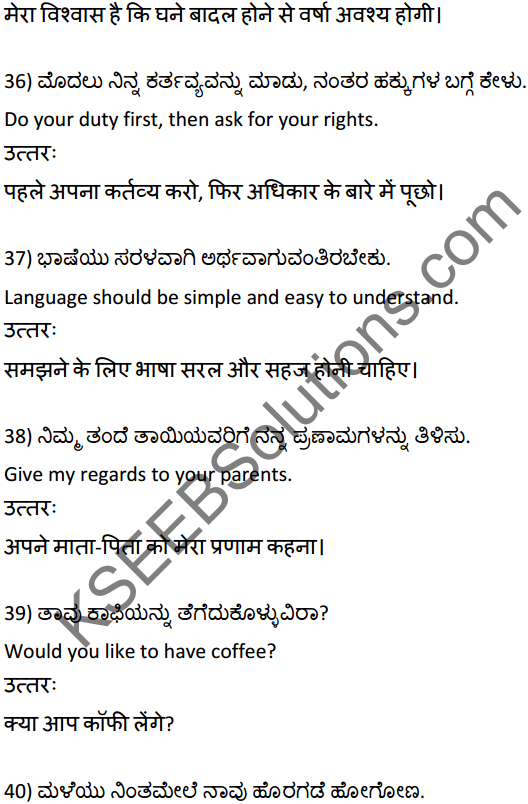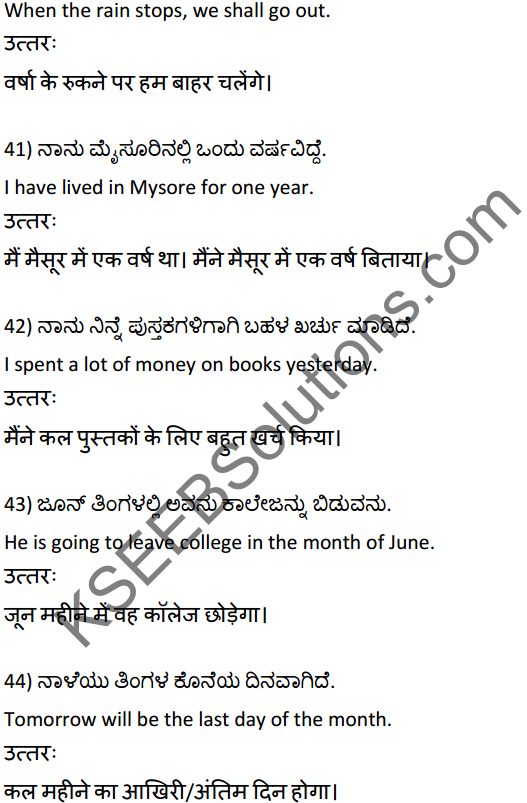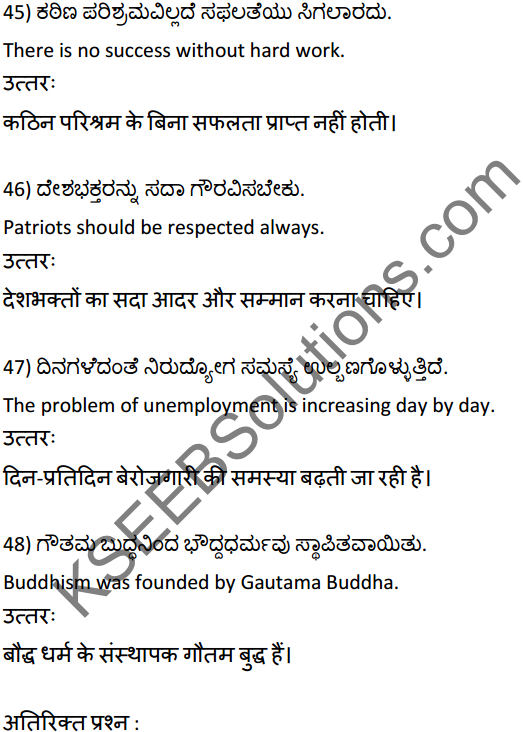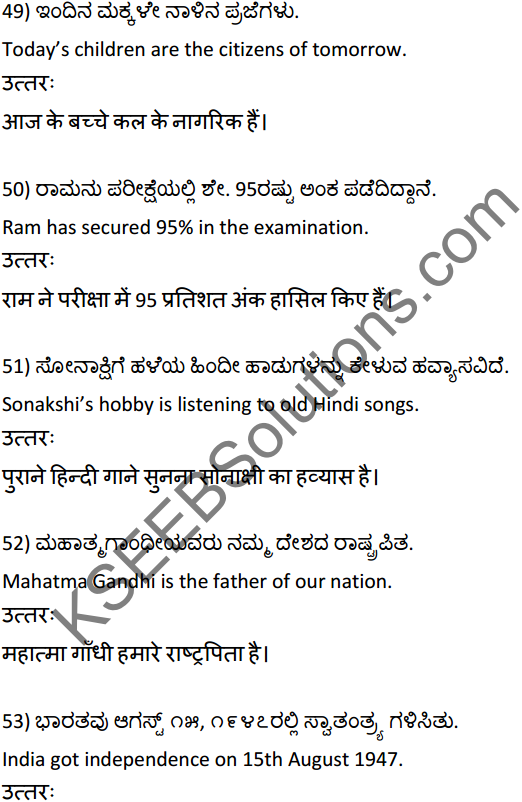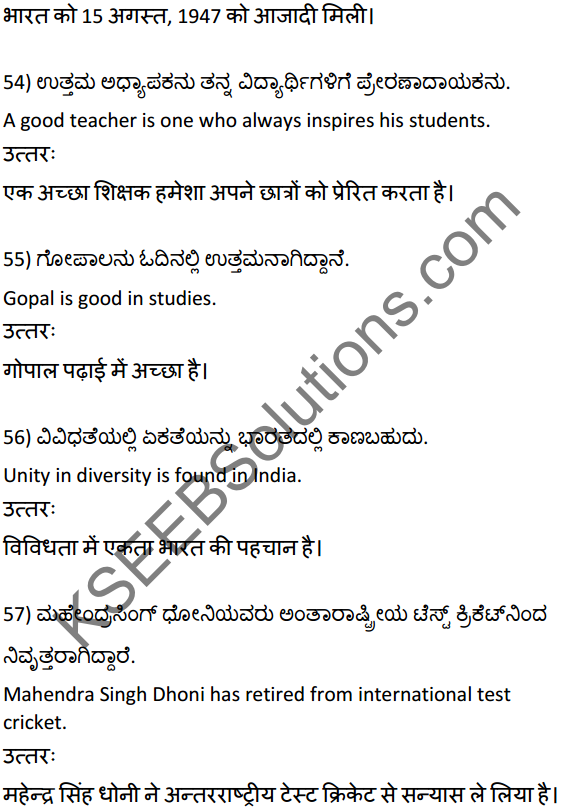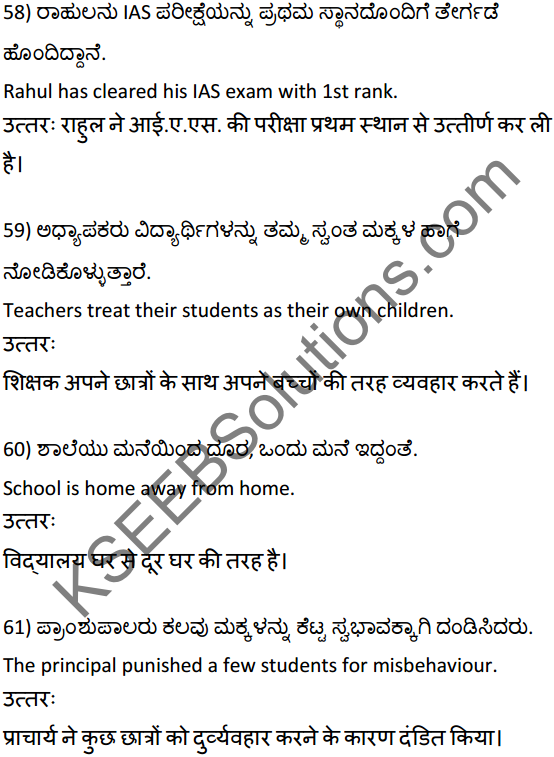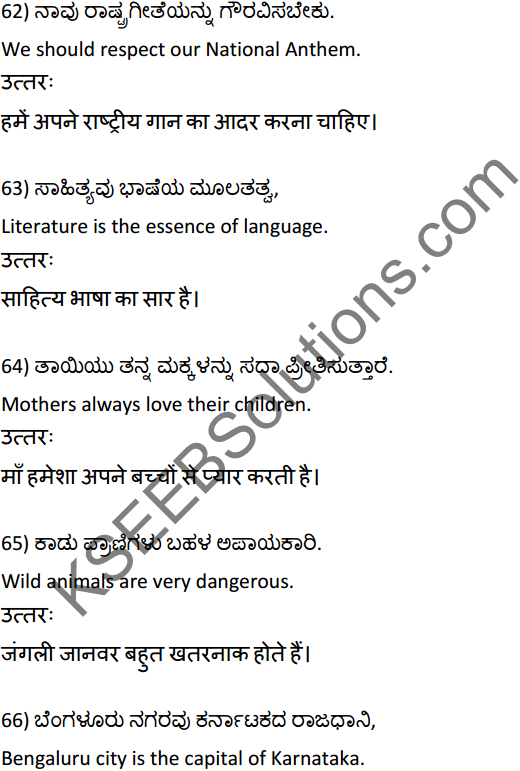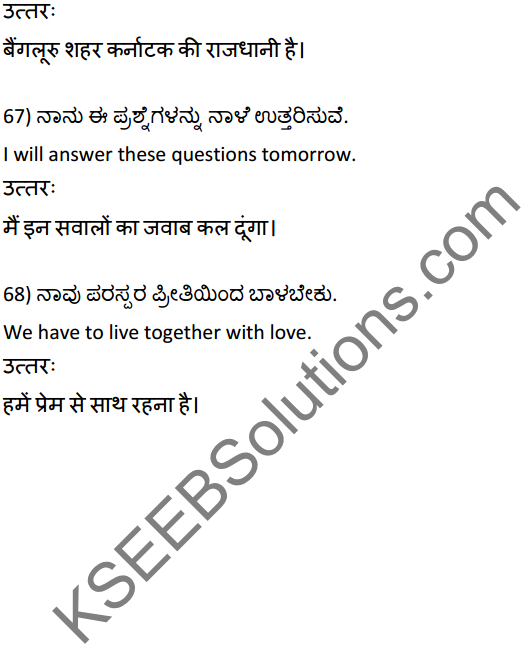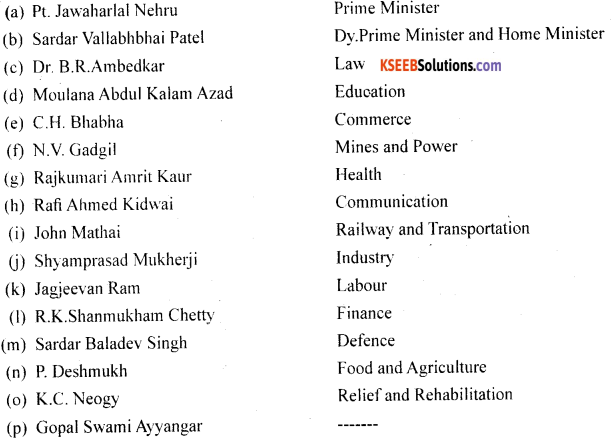Karnataka 2nd PUC Political Science Question Bank Chapter 4 Social Movements and Their Political Implications
You can Download Chapter 4 Social Movements and Their Political Implications, Notes, 2nd PUC Political Science Question Bank with Answers Karnataka State Board Solutions help you to revise complete Syllabus and score more marks in your examinations.
2nd PUC Political Science Social Movements and Their Political Implications One Mark Questions and Answers
Question 1.
Name one of the important personalities who tried to remove caste based discrimination.
Answer:
Basavanna tries to remove caste based discrimination.
Question 2.
Mention the three mantras of Dr.B.R. Ambedkar.
Answer:
Educate. Agitate. Organise are the three mantras of Dr. B.R. Ambedkar.
Question 3.
Who are dalits?
Answer:
Dalits are those who are economically, socially, educationally, culturally exploited.
Question 4.
What is the other name for dalits?
Answer:
Adi Karnataka. Adi Dravida, Adi Andhra. Adi Jambhava, Adi Mahar are the other names of for dalits.
![]()
Question 5.
Who are Panchamas?
Answer:
A group of people who are away from the society and separated from the four varnas are called Panchamas.
Question 6.
What is the criteria to identify one’s caste?
Answer:
The criteria to identify one’s caste is by birth.
Question 7.
Name one of great humans who laid the foundation for dalits emancipation.
Answer:
Dr.B.R.Ambedkar laid the foundation for dalits emancipation.
Question 8.
Who was the victim for caste based discrimination?
Answer:
Dalits are the victim for caste based discrimination.
Question 9.
Who lead the mass in the entry of Kalaram temple? (July 2018)
Answer:
Dr.B.R.Ambedkar lead the mass in the entry of Kalaram temple.
Question 10.
How many varnas prevailed in Vedic period?
Answer:
There were 4 varnas prevailed in vedic period.
Question 11.
Who started the news paper “Mooka Naika”? (July 2015)
Answer:
Dr.B.R.Ambedkar started the news paper “Mooka Naika’.
Question 12.
Name one of the movements lead by Dr. B.R.Ambedkar.
Answer:
The movements lead by Dr.B.R.Ambedkar was Bahishkrith Hitakarini Sabha.
Question 13.
Where did Dalit Andolan started?
Answer:
Dalit Andolan w’as started in Karnataka.
Question 14.
Which article of the constitution deals with ‘Equality Before Law’?
Answer:
Article 14 of the Constitution of India deals with ‘Equality before law’.
Question 15.
When did the Prevention of Attrocities Act passed?
Answer:
The Prevention of Attrocities Act was passed in 1989.
Question 16.
When was Manusmriti implemented?
Answer:
The Manusmriti was implemented in 185 B.C
Question 17.
Who are called as backward classes?
Answer:
A group of people who are backwarded economically, socially and educationally, are called backward classes.
Question 18.
Name the concept emphasized by Jyothibha Phule.
Answer:
The concept emphasized by Jyothibha Phule was “Akshara Kranthi’.
Question 19.
Who started ‘Akshara Kranthi’?
Answer:
Jyothibha Phule started “Aakshara Kranthi.
Question 20.
What is social discrimination? (March 2018)
Answer:
Opportunities were denied on the basis of caste and religion in the society is called social discrimination.
![]()
Question 21.
What is economic exploitation? (July 2016)
Answer:
Exploitation by the haves over haves not is called economic exploitation.
Question 22.
Who was the first one to introduce reservation to Backward Classes?
Answer:
Sayyaji Rao Gaikwad of Gwalior was the first one to introduce reservation to backward classes.
Question 23.
Which article of the constitution provides reservation in public employment for Backward Classes?
Answer:
Article 16(4) of the Constitution of India provides reservation in public employment for backward classes.
Question 24.
Who is authorized to appoint National Backward Classes Commission?
Answer:
The President is authorized to appoint the National Backward Classes Commission.
Question 25.
Expand NHRC.
Answer:
National Human Rights Commission.
Question 26.
When was the Mandal Commission report come into effect?
Answer:
The Mandal Commission Report was came into effect on 7th August 1990.
Question 27.
Name the persons who struggled to eradicate the Sati system.
Answer:
Sri Raja Ram Mohan Rai struggled to eradicate the Sati system.
Question 28.
When was the Widow Remarriage Act implemented?
Answer:
The Widow Remarriage Act was implemented in 1856.
Question 29.
When was NHRC established ? (March 2018)
Answer:
The NHRC was established in 1994.
Question 30.
Mention one of the functions of NHRC.
Answer:
It conduct the enquiries whenever the human rights are violated.
Question 31.
To which state Savitribai Phule belongs to.
Answer:
Savitribai Phule belongs to Maharashtra.
Question 32.
When was the Domestic Violence Act enforced? (July 2018)
Answer:
The Domestic Violence Act was enforced in 2005
Question 33.
What is State Human Rights Commission?
Answer:
Answer:
An authority to enquire about the violation of human rights with in the jurisdiction of state is called State Human Rights Commission.
Question 34.
When was SHRC was set up in Karnataka?
Answer:
The State Human Rights Commission was set up in 2005.
Question 35.
Who is authorized to look into the details of exploitation of children?
Answer:
The Deputy Commissioner is authorised to look into the details of exploitation of children.
Question 36.
Name one of the matters that child helpline looks into.
Answer:
The Child Help Line register the complaints in matters relating to child labour, child abuse, encouraging begging and others.
Question 37.
Who are called labourers?
Answer:
The workers who invest their physical labour either on agriculture or industry are called labourers.
Question 38.
Expand AITUC.
Answer:
All India Trade Union Congress.
Question 39.
Expand INTUC.
Answer:
Indian National Trade Union Congress.
Question 40.
Which part of the Constitution deals with the Directive Principles of State Policy?
Answer:
Part-IV of the Constitution deals with the Directive Principles of State Policy.
![]()
Question 41.
Expand HMS.
Answer:
Hind Mazdoor Sabha.
Question 42.
HQ Expand BMS.
Answer:
Bharatiya Mazdoor Sangh
Question 43.
Which day is celebrated as Labours Day? (March 2018)
Answer:
1st of May is celebrated as Labours Day.
Question 44.
Which is the basic profession of Peasants?
Answer:
The basic profession of peasants is agriculture.
Question 45.
Name one of the leaders who fought for the cause of Peasants in Karnataka. (March 2018)
Answer:
Prof.M.D. Nanjundaswamy fought for the cause of peasants in Karnataka.
Question 46.
Expand BKU.
Answer:
Bharatiya Kisan Union.
Question 47.
Expand NCIP.
Answer:
National Crop Insurance Programme.
Question 48.
Expand NAIS.
Answer:
National Agricultural Insurance Scheme.
Question 49.
Expand PLD.
Answer:
Primary Land Development Bank.
Question 50.
Expand NDC.
Answer:
National Development Council.
Question 51.
Expand KRRS.
Answer:
Karnataka Rajya Raitha Sanglta.
Question 52.
ESI Expand UDHR.
Answer:
Universal Declaration of Human Rights.
Question 53.
Name the head who protects the Human Rights at the district level.
Answer:
Deputy Commissioner protects the Human Rights at the district level.
Question 54.
What is deforestation?
Answer:
Human beings are exploiting the resources of nature and misusing the forest for their selfish motives, it is called deforestation.
Question 55.
Who is the architect of CHIPKO movement?
Answer:
Chandi Prasad is the architect of CHIPKO Movement.
Question 56.
Who is the architect of APPIKO movement?
Answer:
People of Malnad area started the APPIKO Movement.
Question 57.
Where was APPIKO movement started?
Answer:
APPIKO Movement was started in Malnad area of Karnataka.
Question 58.
Who is the main leader of Narmada Bachavo Andolan?
Answer:
Baba Ampte and Medha Patkar are the leaders of Narmada Bachavo Andolan.
Question 59.
Who filed an affidavit in the Supreme Court for Ganga water cleaning?
Answer:
Sri M.C. Mehta filed an affidavit in the Supreme Court for Ganga Water Cleaning.
Question 60.
When was the Bio-Diversity Act come into effect?
Answer:
The Bio-Diversity Act was came into effect in 2002.
![]()
Question 61.
Which is the native district of Saalumarada Thimmakka? (March 2015)
Answer:
Ramanagara is the native district of Saalumarada Thimmakka.
Question 62.
Who started the Western Ghat Movement?
Answer:
Environmentalists of Shivamogga started Western Ghat Movement.
Question 63.
Which day is celebrated as the ‘World Environment Day? (July 22017)
Answer:
5 of June is celebrated as the ‘World Environment Daw
2nd PUC Political Science Social Movements and Their Political Implications Two marks questions and answers:
Question 1.
Mention the cause for Dalit movement.
Answer:
(a) Social injustice
(b) Economic inequality
Question 2.
Who started Dalit Sangarsha Samithi in Karnataka and when?
Answer:
Dalit Sangarsh Samithi was started by Prof.B.Krishnappa in 1974.
Question 3.
What is the specialty of Dalit Act?
Answer:
The speciality of Dalit Act is to take necessary’ action against the attrocities on dalits and impose penalty’ under section 21 of the Act. It also provides legal aid to the victims of attrocities.
Question 4.
Name the varnas that prevailed in the ancient period. (March 2015)
Answer:
(a) Brahmana
(b) Kshatriya
(c) Vaishya
(d) Shudra.
Question 5.
When was the Backward Class agitation started in Karnataka and where?
Answer:
The backward class agitation was started in Karnataka in 1920 I Mysore Province.
Question 6.
How dalits were exploited?
Answer:
Dalits are denied to use public well water, pond and restricted to enter into the temples.
Question 7.
When did Hindu Widows Home established and where? (July 2015)
Answer:
The Hindu Widows Home was established in 1899 in Poona.
Question 8.
Why dalits were kept away from political participation?
Answer:
To get lion share by the upper class in the political field, the dalits have been kept away from political participation.
Question 9.
By which name dalit andolan are called in Andhra Pradesh and Tamil Nadu?
Answer:
The dalits are called Adi Andhra in Andhra Pradesh and Adi Dravida in Tamilnadu.
Question 10.
Mention any two Articles which eradicate the gender based inequality.
Answer:
Article 14 and 15 narrates the eradication of gender based inequality.
![]()
Question 11.
Name any two Acts which is related to Women Protection. (July 2016)
Answer:
(a) Domestic Violence Act 2005.
(b) Dowry Prohibition Act 1961.
Question 12.
When the Manusmrithi was implemented and by whom?
Answer:
The Manusmrithi was implemented in 185 BC by Pushyamithra Shrunga.
Question 13.
Name anv two backward communities.
Answer:
Kuruba and Madiwala are the two backward communities.
Question 14.
What was the demand of Jyothiba Phule with regard to the students of Backward Community?
Answer:
(a) Promoting literacy through Akshara Kranthi Scheme.
(b) Demanding school facilities and residential facilities to backward class students.
Question 15.
Name any two leaders who fought for the upliftment of Backward Classes in Mysore region.
Answer:
Nalwadi Krishnaraja Wodeyar and Kantharaje Urs are the two leaders who fought for the upliftment of Backward Classes in Mysore region.
Question 16.
Name the jurisdiction of NHRC.
Answer:
It enquire the cases relating to the violation of human rights in any part of the countn with the help of judiciary.
Question 17.
Name any two important communist leaders of India?
Answer:
(a) S.V. Dhange.
(b) C.P. Dutt are the two communist leaders of India.
Question 18.
Name any two Labour Acts.
Answer:
(a) Employees State Insurance Act of 1948.
(b) Employees Bonus Act of 1965 are the two Labour Acts.
Question 19.
Mention any two social security measures for labourers.
Answer:
(a) Providing job security.
(b) Providing Insurance facilities are the two social security measures for labourers.
Question 20.
Write two important reasons for Kheda Movement.
Answer:
(a) Bengal Government banned Blue crop and acquired farmer’s land.
(b) They imposed heavy taxes and enhanced the prices.
Question 21.
What is the meaning of Human Rights?
Answer:
The rights which are not separated from the human beings are called human rights.
Question 22.
Write two causes for the Peasant Movement.
Answer:
(a) Negligence of farmers problem.
(b) Unscientific land acquisition.
Question 23.
What is maryade hatye? (July 2018)
Answer:
Elders of family, to maintain family respect and values go to the extent of killing their daughter if she heading towards inter caste and inter religious marriage.
Question 24.
What is environment? (March 2016)
Answer:
A sum total of all biotic and abiotic (living and non-living) factors and conditions that surround us is called environment.
Question 25.
Name any two Acts which relates to the protection of environment.
Answer:
(a) Water (Prevention and control of pollution) Act 1974.
(b) Environment Maintenance Act of 1986 are the two Acts which relates to the protection of environment.
Question 26.
Who started Bahishkrit Hitakarini Sabha and when?
Answer:
Dr. B.R. Ambedkar started Bahishkrit Hitakarini Sabha in 1924.
![]()
2nd PUC Political Science Social Movements and Their Political Implications Five marks questions and answers:
Question 1.
Write the causes for Dalit Movement. (March 2016, 2019)
Answer:
Causes for Dalit Movement:
(a) Social injustice: As per the law of nature, all men are born equally. But in practice, equal treatment and equal opportunities were denied. Exploitation in society was widespread.
(b) Economic inequality: Dalits worked in the lands of upper caste class and were responsible for the wealth of feudalist upper castes. In spite of it, they were treated inhumanly and were not given proper share.
(c) Discrimination: It was rampant in all walks of life. They were not allowed to enter into the temples and not allowed to use the water from public ponds.
(d) Lack of awareness: Dalits were deprived of educational facilities which lead to lack of awareness. Hence atrocities mounted up. To create awareness dalit movement started.
Question 2.
Make a note on legislative provisions in the Constitution for dalits.
Answer:
Legislative provisions in the constitution for Dalits are:
(a) As per Article 14, there should be equality before law.
(b) As per Article 15(1) and (2) there should be no discrimination on the basis of caste.
(c) As per Article 15(4) special provisions have been provided to the weaker sections.
(d) As per Article 16 equal opportunities have been provided in public employment and reservation in appointment and promotion.
(e) As per Article 17 untouchability has been prohibited.
(f) As per Article 38 the state shall strive to promote welfare of the people minimize inequalities in income and eliminate inequalities in status, facilities and opportunities.
(g) As per Article 39(a) the state shall direct its police towards securing right to adequate means of livelihood.
(h) As per Article 46 there shall be no social injustice and exploitation on SC ST community.
(i) As per Article 243D and 243T reservation has been provided for SC’s and STs in local body elections.
(j) As per Article 332 reservation has been provided for SCs and STs in Lok Sabha and State Assembly elections.
Question 3.
Write the reasons for Backward Classes Movement (March 2017)
Answer:
The causes for Backward Classes Movement are:
(a) Social discrimination: These communities faced social discrimination like superior and inferior throughout the years. They were not allowed to come to the main stream.
(b) Economic exploitation: Exploitation leads to economic inequality along the Backward Classes. Many of these communities were ‘Below Poverty Line” and were poverty stricken.
(c) Educational backwardness: Upper castes monopolized the field of education and denied access to these communities. The backward class communities were totally neglected from these facilities.
(d) Denial of political representation: A few communities dominated political field and other backward classes were totally neglected and thus their representation was not enough.
(e) unification: It is difficult to achieve anything without unity and integrity. Hence Backward Classes who are more than 350 in number were unorganized and scattered. To unite them and to fight for their cause, movements were started.
Question 4.
Make a note on the Constitutional Provisions in favour of Backward Classes. (March 2018)
Answer:
Constitutional Provisions in favour of Backward Classes are as follow:
(a) As per article 16(4) reservation has been provided for Backward Classes.
(b) According to Article 340 the President of India is authorized to appoint National Backward Classes Commission.
(c) National Backward Classes Finance and Development Corporation is formed to provide loan and financial assistance to the backward classes.
(d) All the States can form State Backward Classes Commissions and Development Corporations for the welfare of the Backward Classes.
(e) The National Human Rights Commission receives complaints against the violation of rights and discrimination against Backward Classes.
![]()
Question 5.
Mention the other provisions for OBC’s in Constitution.
OR
Write a note on Mandal Commission.
Answer:
Other Provisions for Backward Classes in the Constitution:
(a) The Government of India appointed Backward Classes Commission headed by Kaka Kalelkar in 1953.
(b) The Union Government appointed the commission headed by B.P. Mandal in 1979 to recommend the reservation for Backward Classes.
(c) On the recommendations of the Mandal Commission. 27% of reservation facilities have been provided to Backward Classes in both Central and State Governments.
(d) The maximum age limit has been enhanced for Backward Classes in Public employment.
Question 6.
Write the causes of Feminist Movement (March 2015,2016,2018) (July 2015)
Answer:
The causes for Feminist Movement are as follows:
(a) Inequality: It is evident that Indian Society is male dominated and preference is given to the male members. Though men and women are born equally, women are deprived of education, employment, decision making and property rights.
(b) The evils of dowry: The evils of dowry have drawn parents to become debtors, the girls to brothels and uneven ratio through female foeticide and infanticide. As a result of this uneven ratio of men and w7omen in society which leads to rape and other heinous crimes.
(c) Denial of human rights: The atrocities on women have denied the human rights and other. rights like right to life, liberty7, freedom of expression and others.
(d) Social strata based on gender: Men have not spared any of the fields including cultural, social, religious, political and exercise their monopoly and continue their atrocities on women.
(e) Sexual abuse and molestation: Irrespective of age. time and place, sexual harassment and molestation is on in present context in all walks of life.
(f) Domestic violence: Women are exploiting by’ their husbands in the families for various reasons continuously. They became the victims for all the reasons day by day.
Hence for the above all reasons women organize themselves and start agitation.
Question 7.
What are the political implications and legislative measures taken for the improvement of women? (March 2015) (March 2019)
Answer:
Political implications: Feminist movement tries to overcome women exploitation and atrocities. In this behalf various measures have been taken for the empowerment of women as follows:
(a) Constitutional opportunities: Article 14. 15. 15(3), 16, 34(A), 39(B) and 42 of the Constitution of India provides for the removal of inequality and discrimination based on gender.
(b) Legislative measures: Some legislative measures have been taken to eradicate gender based inequality. For example, Rape is a criminal offence under IPC Section 376. kidnapping and using women for illegal purpose is an offence under TPC Section 363-373. Torture for dowry is prohibited under IPC Section 498-A.
(c) Other legislative measures: Family Court Act 1954. Special Marriage Act 1954. Hindu .Marriage Act 1955, The Dowry Prohibition Act 1961. Protection of Women against Domestic Violence Act 2005 and Abolition of Child Marriage Act 2006 have been enforced . to protect the interests of women.
(d) Special privileges for women: National Women Commission was established in 1992 to recommend the government for the improvements of women.
(e) Reservation in local bodies: Through 73ld and 74’h Constitutional Amendment Acts, 33% of seats are reserved for women in Local Body Elections.
(f) National policy of the women empowerment: Department of Women and Child Welfare under the Secretariat of Human Resource Development framed a National Policy for the empowerment of women.
Question 8.
Write a note on the causes for Labour Movement. (March 2015)
Answer:
The causes for Labour Movement are as follows:
(a) Interest of labourers: Generally industrialists concentrate on their profit rather than workers and their welfare. Labours are exploited by way of giving lesser wages, not declaring bonus, extended hours of work, denial of medical facilities, dismissal from service, etc.
(b) Negligence towards employees: The matters concerning to labourers were decided unilaterally by the Apex Body of the company. Naturally the interests of labourers were neglected.
(c) To get facilities: As the labourers are engaged in monotonous physical strain, they need to have a leisure, proper facilities like potable water, cafeteria, toilet rooms, rest rooms, creaches. medical requirements etc., for both men and women.
(d) Welfare programs: The fate of the companies depends upon the welfare and well-being of the workers. They need some benefits like bonus, allowances, loans, insurance, free quarters, transport and education facilities, pension, family pension, etc.
(e) Plight of workers of unorganized sectors: Anganawadi workers, agricultural labourers, workers on daily wages are exploited to the core as they are still fighting for their rights. The above all reasons leads to the Labor Movements.
Question 9.
List out the Constitutional measures taken for the improvement of labourers. (July 2018)
Answer:
To meet the demands of labourers and to provide benefits, the government has taken certain constitutional measures. They are:
(a) Part IV of the Indian Constitution which deals with the Directive Principles of State Policy directs State Governments to adopt socialist measures like equal pay for equal work for both men and women, to provide leave facilities for pregnant women for both prenatal and postnatal care. The concurrent list empowers the governments to legislate on the workers welfare.
(b) The Government of India enforced certain laws for the improvement of labourers. The Labour Laws of 1970 have fixed the wages of workers appointed on contract basis. Workmen Compensation Act of 1923. Salary Payment Act of 1936, Weekly Holidays Act of 1942. Minimum Wages Act of 1948. Employees State Insurance Act of 1948. Employees Provident Fund Act of 1952. Bonus Act of 1965 are the other law7s implemented for the benefit of labourers.
Question 10.
Enumerate the causes for Peasent Movement. (July 2018)
Answer:
The causes for Peasant Movement:
(a) Feeling of deprivation: Peasants are deprived of the facilities when compared to organized
sectors like industry. They face problems like shortage of quality seeds, fertilizers and pesticides, lack of adequate price and support price waiving of loans, subsidies for agricultural implements, insurance for crops, etc. ‘
(b) Negligence of farmers problem: The previous governments have neglected the interests of farmers. In this behalf Bengal Government banned the Blue Crop and acquired farmers’ lands and also imposed heavy taxes.
(c) Unbearable debts: Peasants raise loans from Banks and Financial Institutions but they are not in a position to repay it for reasons like market fluctuation, the tactics of brokers, etc. This leads to unbearable debts and they commit suicide.
(d) Natural calamity: Peasants depend more on monsoon which are usually irregular. Hence it is popularly known as ‘‘Indian agriculture is playing gamble with monsoons”. As a result, floods and famine, diseases to crops, soil erosion leads to infertility of the soil.
(e) Unscientific land acquisition: In the wake of Urbanisation and industrialization, the governments are acquiring cultivable lands of farmers. Many a times, proper compensation is not given and they are not provided with alternate. As a result they become landless and unemployed.
(f) Support price: Amidst innumerable problems, farmers do not get adequate price to their produce. At that time the Government has to intervene and announce support price to the farmers produce. When the Government fails to do so, they intensify agitation.
All the above facts are the main causes for Peasant Movement.
![]()
Question 11.
What are the measures taken by the Government of India to reduce the problems of Peasants?
Answer:
The Governments have taken the following measures to reduce the problems of peasants:
(a) Agricultural Loans: The Governments have made provisions for the farmers to avail National Crop Insurance Programme. National Agricultural Insurance Scheme. Weather based Crop Insurance Scheme and Primary Land Development Bank was established to provide agricultural assistance to the farmers.
(b) National Agricultural Scheme: The National Development Council has made enormous arrangements in 2007 for the agricultural improvements. The National Agricultural Scheme was implemented to determine agricultural policy and provide essential facilities.
(c) Waiving of Debt: When farmers are not able to get the yield to their expectations, they cannot clear the debt. To uplift the farmers from debts, the Governments have taken necessary measures to wane the debts of farmers. This has reduced the suicide and death rate of farmers.
(d) Establishment of Peasant Liason Centre: The Peasant Liason Centres are opened to provide necessary information related to protect the farmers from low quality seeds, fertilisers and protection of crops from diseases.
(e) Veterinary Sendees: Government is providing veterinary sendee to the livestock which also supports agriculture. It also encouraging dairying and saavayava krishi.
(f) Land Reforms Act: National Land Reforms Act was implemented to provide justice to the real fanners.
Question 12.
Write a note on the unscientific land acquisition.
Answer:
Unscientific land acquisition is one of the most trouble factor for farmers. It has become so common in the present context. In the name of urbanization and industrialization, the governments are acquiring cultivable lands of farmers. Many a times proper compensation is not given and they are not provided with alternate. As a result they become landless and unemployed. There is a close contact between ruling class and business class for such developments and thus they can get some favours. Finally farmers are going to become victims in this juncture.
Question 13.
What are the causes for Human Rights Movement? (July 2016)
Answer:
The causes for Human Rights Movement are as follows:
(a) To protect civil liberty: All men are born equally and they had the liberty to shape their lives. But in actual practice dalits. women and children are being suppressed and exploited.
(b) To remove slavery: Slavery is constitutionally banned but is active in many parts of the country. Instances like child labour, bonded labour, etc. are seen frequently.
(c) To protect family life: Every citizen has the right to family life. Due to modernization youths are heading towards inter-caste and inter religious marriages. Elders of family to maintain family respect and values go even to the extent of Maryade Hatye.
(d) To protect the right of Dalaits: Injustice, atrocities, social ostracism, mada-made snana, forced to carry night soil, are all the clear violation of human rights of dalits.
(e) Reject to file cases: Though the aggrieved persons approach the authorities to file the case, it is not filed due to the interference of some politicians of dominant castes.
Question 14.
state the political implicaions of Human rights (March 2017)
Answer:
The political implications of Human Rights Movement are as follows:
(a) National Human Rights Commission: It came into existence on 8th January 1994. It prepares a list of human rights and get the approval by the government, whenever violation is done. Systematic inquiries are to be conducted and transparency should be maintained with the help of judiciary. The Commission has to enact new laws whenever the existing laws do not eater to the needs of the inquiry.
(b) State Human Rights Commission: It came into existence in 2005 to look into the matters of the violation of human rights in the state level. ‘
(c) Child rights: Violation child rights are seen everywhere. The Deputy Commissioner is authorized to look into the details of exploitation on children. Measures are to be taken to register the complaints through Child Help Line in matters relating to child labour, child abuse, etc.
(d) Creating awareness: Awareness are being created in various stages against the violation of human rights. Grievances are disposed speedily so as to provide justice to the concerned.
Question 15.
What are the causes for Environment Movement? (July 2015,2016)
Answer:
The causes for environment movement are as follows:
(a) To protect the environmental degradation: The Government of India has taken measures for economic development including industrial and technological development . This has led to industrialization, urbanization and their adverse effects like loss of cultivable land and on the fertility of the soil.
(b) To protect biodiversity: Deforestation for fuel and construction purposes has left the wild life and birds to become orphan. Hence Chipko, Appiko and save Western Ghats Movements started.
(c) Environment education and consciousness: Living amidst environment, formal education in schools, colleges and non-governmental organisations have created awareness and consciousness among human beings. Programmes, Rallies and Jathas have gone a long way in this direction.
(d) To curb environment decay: The greadiness of the people to excavate and exploit resources have resulted in soil erosion, drying up of rivers and reservoirs, pollution of water, air. sound, etc. To maintain equilibrium and to pressurize the people in power to take measures, these movements emerged.
Question 16.
Mention the political implications of Environment Movement? (July 2017)
Answer:
Matters related to environment protections are inserted through 421,d Constitutional Amendment in Part IV of the Constitution. The Government of India established the National Committee for Environmental Planning. Following are some of the measures to control the pollution and save the environment.
(a) Ganga Water Cleaning Plan: Sri M.C. Mehta, Environmentalist filed an affidavit in Supreme Court with regard to cleaning of the ganga water. The committee appointed by the Union Government recommended to establish a processing unit to clean the drainage water near the river and to stop throwing dead bodies to the river and suggested to construct 28 crematoriums.
(b) Committee Report: Sri S.K. Ghosh and R.C. Trivedi conducted a study on the factors responsible for the pollution in and around Taj Mahal. It submitted its report stating that suitable measures are to be taken to protect the Taj Mahal.
![]()
Question 17.
List out the legislations made by the Government of India on the environmental protection.
Answer:
Legislations made by the Government of India to save the environment are as follows:
(a) Wild Life Protection Act-1972.
(b) Water (Prevention and Control of Pollution) Act 1974.
(c) Protection of Forest Act of 1980.
(d) Air (Prevention and Control of Pollution) Act 1981.
(e) Environmental Maintenance Act of 1986.
(f) Bio Diversity Act of 2002.
(g) Forest (Conservation) Act 1980.
The Government of Karnataka opened Regional Offices to protect the environment effectively. Measures are also taken to punish those who violate the law.
Question 18.
Write a brief note on the achievements of Saalumarada Thimmakka.
Answer:
Thimmakka and Bikkalu Chikkaiali couple of Hulikal village of Magadi Taluk. Ramanagara District were childless. To overcome this, they started planting Banyan saplings in road side between Kudur and Hulikal. They reared, cared and guarded them with their meager earnings with sheer love and affection.
The Government of Karnataka has taken the responsibility of these 248 trees. The great achievement of Saalu Marada Thimmakka is recognized and honoured by awarding Rajyothsava and National Award. A semibar paper was presented in the UN on her contribution to environment. To create awareness among people ‘World Environment Dav‘ is celebrated on 5lh June every year.
2nd PUC Political Science Social Movements and Their Political Implications Ten marks questions and answers:
Question 1.
Explain the causes and political implications of Dalit Movement. (A)
Answer:
Causes:
Causes for Dalit Movement:
(a) Social injustice: As per the law of nature, all men are born equally. But in practice, equal treatment and equal opportunities were denied. Exploitation in society was widespread.
(b) Economic inequality: Dalits worked in the lands of upper caste class and were responsible for the wealth of feudalist upper castes. In spite of it, they were treated inhumanly and were not given proper share.
(c) Discrimination: It was rampant in all walks of life. They were not allowed to enter into the temples and not allowed to use the water from public ponds.
(d) Lack of awareness: Dalits were deprived of educational facilities which lead to lack of awareness. Hence atrocities mounted up. To create awareness dalit movement started.
Political Implications:
Legislative provisions in the constitution for Dalits are:
(a) As per Article 14, there should be equality before law.
(b) As per Article 15(1) and (2) there should be no discrimination on the basis of caste.
(c) As per Article 15(4) special provisions have been provided to the weaker sections.
(d) As per Article 16 equal opportunities have been provided in public employment and reservation in appointment and promotion.
(e) As per Article 17 untouchability has been prohibited.
(f) As per Article 38 the state shall strive to promote welfare of the people minimize inequalities in income and eliminate inequalities in status, facilities and opportunities.
(g) As per Article 39(a) the state shall direct its police towards securing right to adequate means of livelihood.
(h) As per Article 46 there shall be no social injustice and exploitation on SC ST community.
(i) As per Article 243D and 243T reservation has been provided for SC’s and STs in local body elections.
(j) As per Article 332 reservation has been provided for SCs and STs in Lok Sabha and State Assembly elections.
![]()
Question 2.
Write the constitutional provisions and political implications of Backward Classes Movement.
Answer:
Constitutional Provisions: Constitutional Provisions in favour of Backward Classes are as follow:
(a) As per article 16(4) reservation has been provided for Backward Classes.
(b) According to Article 340 the President of India is authorized to appoint National Backward Classes Commission.
(c) National Backward Classes Finance and Development Corporation is formed to provide loan and financial assistance to the backward classes.
(d) All the States can form State Backward Classes Commissions and Development Corporations for the welfare of the Backward Classes.
(e) The National Human Rights Commission receives complaints against the violation of rights and discrimination against Backward Classes.
Political Implications: Other Provisions for Backward Classes in the Constitution:
(a) The Government of India appointed Backward Classes Commission headed by Kaka Kalelkar in 1953.
(b) The Union Government appointed the commission headed by B.P. Mandal in 1979 to recommend the reservation for Backward Classes.
(c) On the recommendations of the Mandal Commission. 27% of reservation facilities have been provided to Backward Classes in both Central and State Governments.
(d) The maximum age limit has been enhanced for Backward Classes in Public employment.
Question 3.
Describe the causes and political implications of Feminist Movement.
Answer:
Causes: The causes for Feminist Movement are as follows:
(a) Inequality: It is evident that Indian Society is male dominated and preference is given to the male members. Though men and women are born equally, women are deprived of education, employment, decision making and property7 rights.
(b) The evils of dowry: The evils of dowry have drawn parents to become debtors, the girls to brothels and uneven ratio through female foeticide and infanticide. As a result of this uneven ratio of men and women in society which leads to rape and other heinous crimes.
(c) Denial of human rights: The atrocities on women have denied the human rights and other. rights like right to life, liberty7, freedom of expression and others.
(d) Social strata based on gender: Men have not spared any of the fields including cultural, social, religious, political and exercise their monopoly and continue their atrocities on women.
(e) Sexual abuse and molestation: Irrespective of age. time and place, sexual harassment and molestation is on in present context in all walks of life.
(f) Domestic violence: Women are exploiting by’ their husbands in the families for various reasons continuously. They became the victims for all the reasons day by day.
Hence for the above all reasons women organize themselves and start agitation.
Political Implications: Political implications: Feminist movement tries to overcome women exploitation and atrocities. In this behalf various measures have been taken for the empowerment of women as follows:
(a) Constitutional opportunities: Article 14. 15. 15(3), 16, 34(A), 39(B) and 42 of the Constitution of India provides for the removal of inequality and discrimination based on gender.
(b) Legislative measures: Some legislative measures have been taken to eradicate gender based inequality. For example, Rape is a criminal offence under IPC Section 376. kidnapping and using women for illegal purpose is an offence under TPC Section 363-373. Torture for dowry is prohibited under IPC Section 498-A.
(c) Other legislative measures: Family Court Act 1954. Special Marriage Act 1954. Hindu .Marriage Act 1955, The Dowry Prohibition Act 1961. Protection of Women against Domestic Violence Act 2005 and Abolition of Child Marriage Act 2006 have been enforced . to protect the interests of women.
(d) Special privileges for women: National Women Commission was established in 1992 to recommend the government for the improvements of women.
(e) Reservation in local bodies: Through 73ld and 74’h Constitutional Amendment Acts, 33% of seats are reserved for women in Local Body Elections.
(f) National policy of the women empowerment: Department of Women and Child Welfare under the Secretariat of Human Resource Development framed a National Policy for the empowerment of women.
![]()
Question 4.
Explain the causes and political implications of Peasant Movement.
Answer:
Causes: The causes for Peasant Movement:
(a) Feeling of deprivation: Peasants are deprived of the facilities when compared to organized
sectors like industry. They face problems like shortage of quality seeds, fertilizers and pesticides, lack of adequate price and support price waiving of loans, subsidies for agricultural implements, insurance for crops, etc. ‘
(b) Negligence of farmers problem: The previous governments have neglected the interests of farmers. In this behalf Bengal Government banned the Blue Crop and acquired farmers’ lands and also imposed heavy taxes.
(c) Unbearable debts: Peasants raise loans from Banks and Financial Institutions but they are not in a position to repay it for reasons like market fluctuation, the tactics of brokers, etc. This leads to unbearable debts and they commit suicide.
(d) Natural calamity: Peasants depend more on monsoon which are usually irregular. Hence it is popularly known as ‘‘Indian agriculture is playing gamble with monsoons”. As a result, floods and famine, diseases to crops, soil erosion leads to infertility of the soil.
(e) Unscientific land acquisition: In the wake of Urbanisation and industrialization, the governments are acquiring cultivable lands of farmers. Many a tines, proper compensation is not given and they are not provided with alternate. As a result they become landless and unemployed.
(f) Support price: Amidst innumerable problems, farmers do not get adequate price to their produce. At that time the Government has to intervene and announce support price to the farmers produce. When the Government fails to do so, they intensify agitation.
All the above facts are the main causes for Peasant Movement.
Political Implications: The Governments have taken the following measures to reduce the problems of peasants:\
(a) Agricultural Loans: The Governments have made provisions for the farmers to avail National Crop Insurance Programme. National Agricultural Insurance Scheme. Weather based Crop Insurance Scheme and Primary Land Development Bank was established to provide agricultural assistance to the farmers.
(b) National Agricultural Scheme: The National Development Council has made enormous arrangements in 2007 for the agricultural improvements. The National Agricultural Scheme was implemented to determine agricultural policy and provide essential facilities.
(c) Waiving of Debt: When farmers are not able to get the yield to their expectations, they cannot clear the debt. To uplift the farmers from debts, the Governments have taken necessary measures to wane the debts of farmers. This has reduced the suicide and death rate of farmers.
(d) Establishment of Peasant Liason Centre: The Peasant Liason Centres are opened to
provide necessary information related to protect the farmers from low quality seeds, fertilisers and protection of crops from diseases.
(e) Veterinary Sendees: Government is providing veterinary sendee to the livestock which also supports agriculture. It also encouraging dairying and saavayava krishi.
(f) Land Reforms Act: National Land Reforms Act was implemented to provide justice to the real fanners.
Question 5.
Describe the causes and political implications of Labour Movement.
Answer:
Causes: The causes for Labour Movement are as follows:
(a) Interest oflabourers: Generally industrialists concentrate on theirprofit rather than workers and their welfare. Labours are exploited by way of giving lesser wages, not declaring bonus, extended hours of work, denial of medical facilities, dismissal from service, etc.
(b) Negligence towards employees: The matters concerning to labourers were decided unilaterally by the Apex Body of the company. Naturally the interests of labourers were neglected.
(c) To get facilities: As the labourers are engaged in monotonous physical strain, they need to have a leisure, proper facilities like potable water, cafeteria, toilet rooms, rest rooms, creaches. medical requirements etc., for both men and women.
(d) Welfare programs: The fate of the companies depends upon the welfare and well-being of the workers. They need some benefits like bonus, allowances, loans, insurance, free quarters, transport and education facilities, pension, family pension, etc.
(e) Plight of workers of unorganized sectors: Anganawadi workers, agricultural labourers, workers on daily wages are exploited to the core as they are still fighting for their rights. The above all reasons leads to the Labor Movements.
Political Implications: To meet the demands of labourers and to provide benefits, the government has taken certain constitutional measures. They are:
(a) Part IV of the Indian Constitution which deals with the Directive Principles of State Policy directs State Governments to adopt socialist measures like equal pay for equal work for both men and women, to provide leave facilities for pregnant women for both prenatal and postnatal care. The concurrent list empowers the governments to legislate on the workers welfare.
(b) The Government of India enforced certain laws for the improvement of labourers. The Labour Laws of 1970 have fixed the wages of workers appointed on contract basis.
Workmen Compensation Act of 1923. Salary Payment Act of 1936, Weekly Holidays Act of 1942. Minimum Wages Act of 1948. Employees State Insurance Act of 1948. Employees Provident Fund Act of 1952. Bonus Act of 1965 are the other law7s implemented for the benefit of labourers.
Question 6.
Describe the causes and political implications of Human Rights Movement.
Answer:
Causes: The causes for Human Rights Movement are as follows:
(a) To protect civil liberty: All men are born equally and they had the liberty to shape their lives. But in actual practice dalits. women and children are being suppressed and exploited.
(b) To remove slavery: Slavery is constitutionally banned but is active in many parts of the country. Instances like child labour, bonded labour, etc. are seen frequently.
(c) To protect family life: Every citizen has the right to family life. Due to modernization youths are heading towards inter-caste and inter religious marriages. Elders of family to maintain family respect and values go even to the extent of Maryade Hatye.
(d) To protect the right of Dalaits: Injustice, atrocities, social ostracism, mada-made snana, forced to carry night soil, are all the clear violation of human rights of dalits.
(e) Reject to file cases: Though the aggrieved persons approach the authorities to file the case, it is not filed due to the interference of some politicians of dominant castes.
Political Implications: The political implications of Human Rights Movement are as follows:
(a) National Human Rights Commission: It came into existence on 8th January 1994. It prepares a list of human rights and get the approval by the government, whenever violation is done. Systematic inquiries are to be conducted and transparency should be maintained with the help of judiciary. The Commission has to enact new laws whenever the existing laws do not eater to the needs of the inquiry.
(b) State Human Rights Commission: It came into existence in 2005 to look into the matters of the violation of human rights in the state level. ‘
(c) Child rights: Violation child rights are seen everywhere. The Deputy Commissioner is authorized to look into the details of exploitation on children. Measures are to be taken to register the complaints through Child Help Line in matters relating to child labour, child abuse, etc.
(d) Creating awareness: Awareness are being created in various stages against the violation of human rights. Grievances are disposed speedily so as to provide justice to the concerned.
![]()
Question 7.
Explain the causes and political implications of Environment Movement.
Answer:
Causes: The causes for environment movement are as follows:
(a) To protect the environmental degradation: The Government of India has taken measures for economic development including industrial and technological development . This has led to industrialization, urbanization and their adverse effects like loss of cultivable land and on the fertility of the soil.
(b) To protect biodiversity: Deforestation for fuel and construction purposes has left the wild life and birds to become orphan. Hence Chipko, Appiko and save Western Ghats Movements started.
(c) Environment education and consciousness: Living amidst environment, formal education in schools, colleges and non-governmental organisations have created awareness and consciousness among human beings. Programmes, Rallies and Jathas have gone a long way in this direction.
(d) To curb environment decay: The greadiness of the people to excavate and exploit resources have resuited in soil erosion, drying up of rivers and reservoirs, pollution of water, air. sound, etc. To maintain equilibrium and to pressurize the people in power to take measures, these movements emerged.
Political Implications: Matters related to environment protections are inserted through 421,d Constitutional Amendment in Part IV of the Constitution. The Government of India established the National Committee for Environmental Planning. Following are some of the measures to control the pollution and save the environment.
(a) Ganga Water Cleaning Plan: Sri M.C. Mehta, Environmentalist filed an affidavit in Supreme Court with regard to cleaning of the ganga water. The committee appointed by the Union Government recommended to establish a processing unit to clean the drainage water near the river and to stop throwing dead bodies to the river and suggested to construct 28 crematoriums.
(b) Committee Report: Sri S.K. Ghosh and R.C. Trivedi conducted a study on the factors responsible for the pollution in and around Taj Mahal. It submitted its report stating that suitable measures are to be taken to protect the Taj Mahal.
